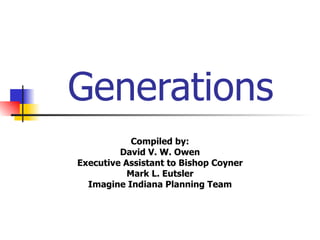Generations (UMC Imagine Indiana Planning Team Resource 2006)
- 1. Generations Compiled by: David V. W. Owen Executive Assistant to Bishop Coyner Mark L. Eutsler Imagine Indiana Planning Team
- 2. The Generations Age groups defined by William Strauss and Neil Howe in their book, Generations , which are characterized by a shared coming of age experience.
- 3. Builders (born 1901 to 1924) The generation who built most of the major institutions of the 20th century. Big business, big government, big unions, big universities, big churches... (Strauss and Howe call this group, GIs). Age 82 plus How many in your Church?
- 4. Silents (born 1925 to 1942) The generation who supported and faithfully served the builders. Maintained the greatness of Business, institutions, churches given to them by the previous generation. Age 64-81 How many in your Church?
- 5. Boomers (born 1943 to 1960) The generation of idealists. Born and raised during the postwar boom era. Experienced unprecedented economic/educational/employment opportunties. Success measured by achievement Age 46-63 How many in your Church?
- 6. Survivors (born 1961 - 1981) The neglected children of the younger silent's and the boomers. Their parents were so busy in pursuit of the self that they left their children to fend for themselves. Quite good at surviving. Age 25-45 How many in your Church?
- 7. Millennial (born 1982-- 2001) The youngest living generation, they will have a different childhood. Those on the early end of this generational cohort will suffer from the fiscal crises of our public institutions. The home environment is changing as more value is placed on family and the care of children. Age 5-24 How many in your Church?
- 8. Z Generation (born after 911) While this generation is not yet defined it will grow into a world following 911. They will be influenced by the need for security, global awareness, and the need to be connected relationally. Other characteristics will emerge as this generation enters the educational process.
- 9. A UM Congregation by Age 10% over 80 (Builders) 20% 64-80 (Silent) 30% 46-63 (Boomers) 20% 30-45 (Survivors) 10% 20-30 (Survivors/Millen) 10% under 20 (Millennials-Z)
- 10. Predominant Values by Age Builders (over 80) value Project Silent (64-80) value Protecting Project Boomers (46-63) value Cause Survivors (30-45) value Friend Survivors/Millen (20-30) value Identity Millennials-Z (under 20) value TBD
- 11. Annual Replacement Percentages by Age Necessary for Growth Builders (over 80) Silent (64-80) / 10% Boomers (46-63) ŌĆō 20% Survivors (30-45) Survivors/Millen (20-30) / 40% Millennials-Z (under 20)
- 12. Key Characteristics by Age Builders (over 80) Silent (64-80) / Autocratic Boomers (46-63) ŌĆō Entrepreneurial Survivors (30-45) Survivors/Millen (20-30) / Outsourcers Millennials-Z (under 20) ŌĆōTBD
- 13. Church Relationships by Age Builders (over 80) Loyal no matter Silent (64-80) / what Boomers (46-63) ŌĆō Left Church Survivors (30-45) Do not Survivors/Millen (20-30)ŌĆō know Millennials-Z (under 20) / church
- 14. Are the Generations Different? Educational Level World View Economic Opportunities Understanding/experience of The Church Family Life
- 15. Key Values Across Generations Significance Does my life count? Do I make a difference? Self-actualizing Right way (sense of what to embrace & avoid) Sense of the Other (something beyond me) Language (symbolic language, i.e. liturgy)














